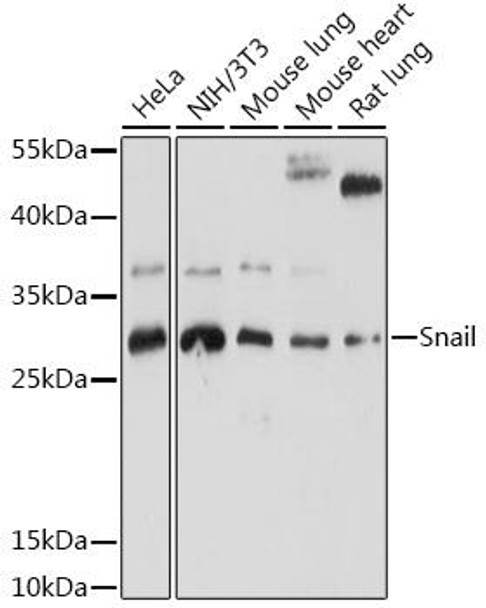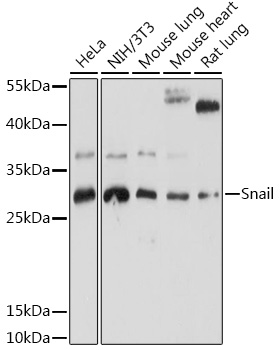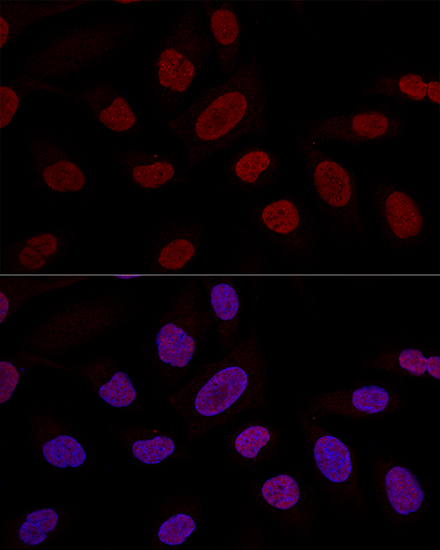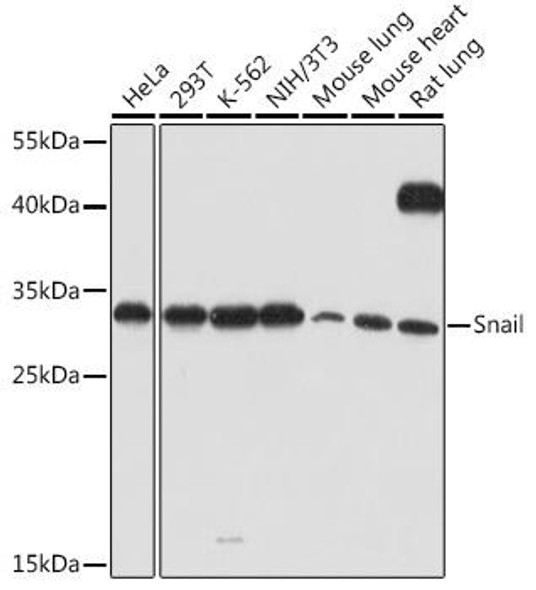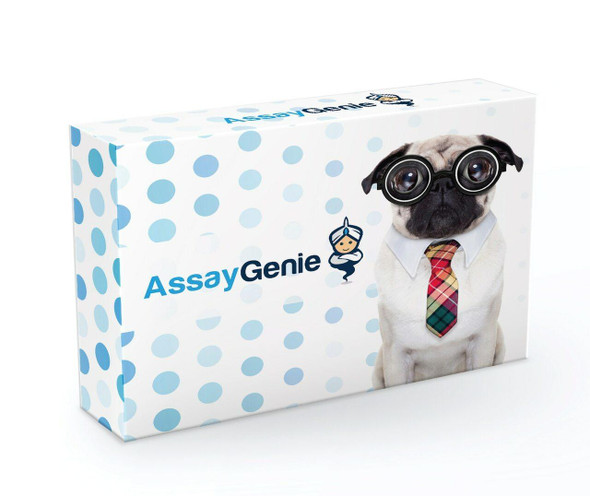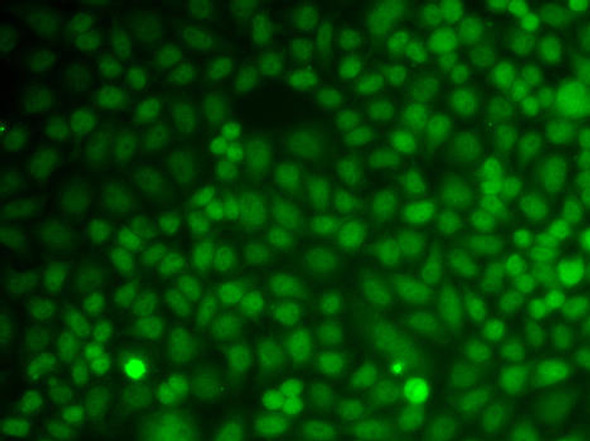Anti-Snail Antibody (CAB12301)
- SKU:
- CAB12301
- Product Type:
- Antibody
- Reactivity:
- Human
- Mouse
- Rat
- Host Species:
- Rabbit
- Isotype:
- IgG
- Antibody Type:
- Polyclonal Antibody
- Research Area:
- Cell Biology
Description
Anti-Snail Antibody (CAB12301)
The SNAI1 Polyclonal Antibody (CAB12301) is a valuable tool for researchers studying the SNAI1 protein, which is known for its role in regulating epithelial-mesenchymal transition (EMT) and promoting tumor metastasis. This antibody, raised in rabbits, exhibits high reactivity with human samples and is validated for use in Western blot applications.SNAI1, also known as Snail, is a transcription factor that plays a critical role in the process of EMT, which is important for embryonic development and cancer progression. By binding specifically to the SNAI1 protein, this antibody enables accurate detection and analysis in various cell types, making it ideal for studies in cancer biology and metastasis research.
Understanding the function and regulation of SNAI1 is key to unraveling the mechanisms behind tumor invasion and metastasis, and targeting SNAI1 may hold promise for developing new therapeutic strategies in cancer treatment. The SNAI1 Polyclonal Antibody is a valuable tool for researchers investigating the molecular pathways involved in these processes and exploring potential targets for anti-cancer therapies.
| Antibody Name: | Anti-Snail Antibody |
| Antibody SKU: | CAB12301 |
| Antibody Size: | 20uL, 50uL, 100uL |
| Application: | WB IHC IF |
| Reactivity: | Human, Mouse, Rat |
| Host Species: | Rabbit |
| Immunogen: | A synthetic peptide corresponding to a sequence within amino acids 200 to the C-terminus of human Snail (NP_005976.2). |
| Application: | WB IHC IF |
| Recommended Dilution: | WB 1:500 - 1:2000 IHC 1:50 - 1:100 IF 1:50 - 1:200 |
| Reactivity: | Human, Mouse, Rat |
| Positive Samples: | HeLa, NIH/3T3, Mouse lung, Mouse heart, Rat lung |
| Immunogen: | A synthetic peptide corresponding to a sequence within amino acids 200 to the C-terminus of human Snail (NP_005976.2). |
| Purification Method: | Affinity purification |
| Storage Buffer: | Store at -20'C. Avoid freeze / thaw cycles. Buffer: PBS with 0.02% sodium azide, 50% glycerol, pH7.3. |
| Isotype: | IgG |
| Sequence: | RTHT GEKP FSCP HCSR AFAD RSNL RAHL QTHS DVKK YQCQ ACAR TFSR MSLL HKHQ ESGC SGCP R |
| Gene ID: | 6615 |
| Uniprot: | O95863 |
| Cellular Location: | Cytoplasm, Nucleus |
| Calculated MW: | 29kDa |
| Observed MW: | 29kDa |
| Synonyms: | SNAI1, SLUGH2, SNA, SNAH, SNAIL, SNAIL1, dJ710H13.1 |
| Background: | The Drosophila embryonic protein snail is a zinc finger transcriptional repressor which downregulates the expression of ectodermal genes within the mesoderm. The nuclear protein encoded by this gene is structurally similar to the Drosophila snail protein, and is also thought to be critical for mesoderm formation in the developing embryo. At least two variants of a similar processed pseudogene have been found on chromosome 2. |
| UniProt Protein Function: | Snail1: a protein of the C2H2-type zinc-finger family that regulates transcription. Involved in embryonic mesoderm formation. Plays a role in the epithelial to mesenchymal transition (EMT). EMT is characterized by decreased levels of the epithelial markers E-cadherin and alpha- and beta-catenin, and increased cellular migration and expression of the mesenchymal markers fibronectin, vimentin, N-cadherin and smooth muscle alpha-actin.E Snail binds to 3 E-boxes of the E-cadherin gene promoter and represses its transcription. NF-kappaB binds and regulates the snail promoter and is critical for EMT, and inhibition of NF-kappaB activity lowered snail levels and morphologically reversed the EMT. |
| UniProt Protein Details: | Protein type:C2H2-type zinc finger protein; Transcription factor Chromosomal Location of Human Ortholog: 20q13.2 Cellular Component: cytoplasm; nucleus Molecular Function:kinase binding; protein binding Biological Process: epithelial to mesenchymal transition; mesoderm formation; negative regulation of DNA damage response, signal transduction by p53 class mediator; negative regulation of transcription from RNA polymerase II promoter; osteoblast differentiation; positive regulation of cell migration; positive regulation of transcription, DNA-dependent |
| NCBI Summary: | The Drosophila embryonic protein snail is a zinc finger transcriptional repressor which downregulates the expression of ectodermal genes within the mesoderm. The nuclear protein encoded by this gene is structurally similar to the Drosophila snail protein, and is also thought to be critical for mesoderm formation in the developing embryo. At least two variants of a similar processed pseudogene have been found on chromosome 2. [provided by RefSeq, Jul 2008] |
| UniProt Code: | O95863 |
| NCBI GenInfo Identifier: | 12644089 |
| NCBI Gene ID: | 6615 |
| NCBI Accession: | O95863.2 |
| UniProt Secondary Accession: | O95863,Q9P113, Q9UBP7, Q9UHH7, B2R842, |
| UniProt Related Accession: | O95863 |
| Molecular Weight: | 29,083 Da |
| NCBI Full Name: | Zinc finger protein SNAI1 |
| NCBI Synonym Full Names: | snail family transcriptional repressor 1 |
| NCBI Official Symbol: | SNAI1 |
| NCBI Official Synonym Symbols: | SNA; SNAH; SNAIL; SLUGH2; SNAIL1; dJ710H13.1 |
| NCBI Protein Information: | zinc finger protein SNAI1 |
| UniProt Protein Name: | Zinc finger protein SNAI1 |
| UniProt Synonym Protein Names: | Protein snail homolog 1; Protein sna |
| Protein Family: | Protein snail |
| UniProt Gene Name: | SNAI1 |
| UniProt Entry Name: | SNAI1_HUMAN |


